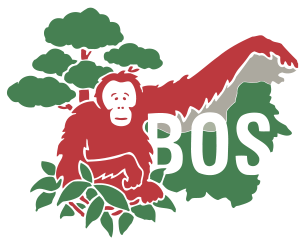CAN ORANGUTANS SURVIVE IN AQUATIC ENVIRONMENTS?

TherOrangutans are arboreal primates. Most of their activities involve navigating the forest canopy by combining climbing, clambering and brachiating. Given that orangutans share 97% of their DNA with humans, it is intriguing to explore how their adaptability might extend beyond the treetops, raising the question: Could they also survive in aquatic environments?
Our red cousins are generally not natural swimmers and tend to avoid water. Both in the wild and in rehabilitation centres, studies and observations consistently show that they steer clear of deep water bodies and rarley swim.
According to research published by Bender et al. (2013), hominoids, including humans, are known for lacking instinctive swimming abilities. Orangutans, in particular, fear deep water bodies and generally avoid them in their natural habitats, both in Borneo and Sumatra. This research also indicates that orangutans are primarily observed around shallow water. Despite not demonstrating significant swimming skills, they still possess the potential to swim if necessary.
Anatomy supports life in the canopies
The ecology and adaptations of orangutans are strongly oriented towards an arboreal life, frequently relying on a combination of fore- and hind limbs for mobility while navigating trees (Thorpe and Crompton, 2008).
Additionally, their functional anatomy has evolved to support climbing, bridging and travelling over flexible branches in the canopy (Zihlman et al., 2011). This has reduced their opportunities to interact with water, leading to diminished innate swimming behaviour. Nevertheless, Bender notes that apes have some ability to cope with negative buoyancy, even though it is limited.

The BOS team observed Sayang and her daughter Padma crossing the Pehpan River multiple times.
Although orangutans are not strong swimmers, they can adapt to environments with abundant water sources. Sometimes, they have been observed using logs or fallen trees to cross rivers or swamps. For example, our Post-Release Monitoring team in the Kehje Sewen Forest has recorded orangutan Sayang and her child, Padma, crossing the Pehpan River multiple times. Another surprising observation is that this resilient mother has been transversing a fallen tree connecting two sides of the river.
Creative problem-solving skills
Additionally, orangutans’ adaptation to water-rich environments is evident in their foraging behaviour. They can forage around shallow water and use simple tools to obtain drinking water or find food in the mud. Thus, while they may lack strong swimming abilities, orangutans demonstrate creative problem-solving skills using tools and materials in their natural surroundings.
Research by Russon et al. (2014) shows that rehabilitated orangutans on the pre-release islands of Kaja and Palas, Central Kalimantan, utilize shallow water to forage for small fish and aquatic plants. The study reveals that these rehabilitated orangutans may obtain protein from insects and aquatic animals. Additionally, they use twigs or leaves to extract food from the mud or shallow water. These behaviours highlight a substantial level of adaptation among orangutans to water-rich environments.
Strong ability to adopt to aquatic environments
So, although orangutans are not natural swimmers and tend to avoid deep water, they demonstrate a strong ability to adapt to environments with abundant water sources. They use simple tools and take advantage of shallow water to forage for food and access drinking water. Further studies are needed to fully understand how orangutans adapt to water-rich environments and how these adaptations influence their survival.
Photos: BOSF/BPI
Reference:
- Bender, R., & Bender, N. (2013). Brief communication Swimming and diving behaviour in apes (Pan troglodytes and Pongo pygmaeus) First documented report. American Journal of Physical Anthropology, 152(1), 156-162.
- Russon, A. E., Compost, A., Kuncoro, P., & Ferisa, A. (2014). Orangutan fish eating, primate aquatic fauna eating, and their implications for the origins of ancestral hominin fish eating. Journal of Human Evolution, 77, 50-63.
- Thorpe, S., Crompton, R. H., & Wich, S. A. (2008). Orangutan positional behaviour: inter-specific variation and ecological correlates. In Orangutans: ecology, evolution, behaviour and conservation.
- Zihlman, A. L., Mcfarland, R. K., & Underwood, C. E. (2011). Functional anatomy and adaptation of male gorillas (Gorilla gorilla gorilla) with comparison to male orangutans (Pongo pygmaeus). The Anatomical Record: Advances in Integrative Anatomy and Evolutionary Biology, 294(11), 1842-1855.



